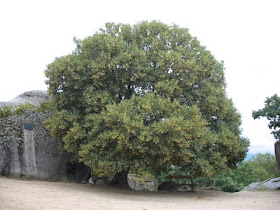
The Japanese Cheesewood tree (species: Pittosporum tobira) is an interesting ornamental tree that is native to Japan but cultivated in other parts of the world in warmer climates. In the US this tree species can be found in California as well as Florida and Georgia. It grows as a small tree or large shrub. Max height is about 20 feet.

Other names that I´ve seen for this tree species are "Japanese mockorange", "Japanese pittosporum" or "Mock Orange". Its tendency to have multiple thick stems that have a sort of twisted, irregular form give this tree a sort of giant bonsai look. It is a great addition to any ornamental garden.

The flowers are small and white and similar in shape to those of the Orange tree. Purhaps for this reason it is sometimes called the "mock orange".

The fruits are small marble shaped seed pods that have a pointy tip on the ends. They grow is small clusters at the terminal ends of the brances often surrounded by a rosetta effect of the stiff, dark green leaves.

The lower parts of the mature branches are usually bare of leaves and smaller brances adding to the ornamental effect. I´m not sure if this is due more to carefull pruning or if this tree species just grows this way naturally. All the specimens I´ve seen have been in gardens so it is hard to tell what the tree might look like in the wild.

The images from the post come from both Málaga and Madrid. The sign below is from a fairly large Japanese cheesewood tree in the Madrid botanical gardens.

 Of the three different "Bauhinia" tree species that I´ve seen growing in Southern Spain the Brazilian Orchid tree (Bauhinia forficata) is the one I have seen the least. It is far less common than its cousin the "Hong Kong Orchid tree" that is found in many cities and towns on the Southern Spanish coast. Another Bauhinia that is not very common is the Purple Orchid tree.
Of the three different "Bauhinia" tree species that I´ve seen growing in Southern Spain the Brazilian Orchid tree (Bauhinia forficata) is the one I have seen the least. It is far less common than its cousin the "Hong Kong Orchid tree" that is found in many cities and towns on the Southern Spanish coast. Another Bauhinia that is not very common is the Purple Orchid tree. The leaves of this tree species have a sort of camel´s foot shape as can be appreciated in the image above. Also of note are the small thorns on the smaller branches and stems. The flowers of the Brazilian orchid tree are similar to those of the Hong Kong orchid tree except that the petals are thinner and longer making this tree´s flowers a bit less attractive than those of its cousins.
The leaves of this tree species have a sort of camel´s foot shape as can be appreciated in the image above. Also of note are the small thorns on the smaller branches and stems. The flowers of the Brazilian orchid tree are similar to those of the Hong Kong orchid tree except that the petals are thinner and longer making this tree´s flowers a bit less attractive than those of its cousins. The seeds of this tree species grow in a long green-been type legum seed pod that measures about 9-11 inches in length.
The seeds of this tree species grow in a long green-been type legum seed pod that measures about 9-11 inches in length. From my observations the best way to tell this "orchid tree" apart from other´s of the same genus is by its slightly smaller leaves and by its flower.
From my observations the best way to tell this "orchid tree" apart from other´s of the same genus is by its slightly smaller leaves and by its flower.





















